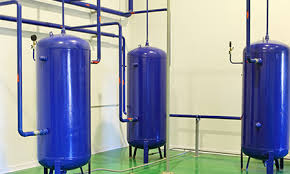-
Call
-
Whatsapp
9825014048
-
Location


Blog


BLOG

Sizing Air Receivers
Compressed air is vital in numerous industrial and commercial applications, powering machinery, tools, and processes across various sectors. Efficient utilisation of compressed air involves selecting the suitable compressors and sizing the supporting components. Air receivers are crucial in stabilising pressure fluctuation, reducing compressor cycling, and storing compressed air for peak demand periods. However, determining the correct capacity for an air receiver requires careful consideration of several factors to ensure optimal performance and energy efficiency.

Understanding the Role of Air Receivers:
Air Receivers act as buffer tanks that store compressed air, allowing for smooth and consistent delivery to downstream equipment. They help minimise pressure variations within the system, which can result from fluctuations in demand or the cyclic operation of compressors. By providing a reserve of compressed air, receivers enable compressors to operate more efficiently by reducing the frequency of starts and stops, known as cycling.
Factors Influencing Air Receiver Sizing:
-
Compressor Capacity: The size and output capacity of compressors supplying the system determine the rate at which compressed air is generated. A larger compressor or a bank of compressors will require a larger air receiver to accommodate the compressed air.
-
Air Demand Profile: It is crucial to analyse the demand profile of your compressed air system. Factors such as peak usage periods, average demand, and intermittent or cyclical demands should be considered. This analysis helps determine the necessary storage capacity of the air receiver to meet fluctuating demand while maintaining pressure levels.
-
Pressure Drop Tolerance: Pressure drop across the system, including piping and downstream equipment, must be considered. The air receiver should be sized to compensate for pressure losses and ensure an adequate compressed air supply is available at the required pressure.
-
Compressor Cycling Rate: Minimising the frequency of compressor starts and stops improves energy efficiency and prolongs equipment life. A properly sized air receiver can help reduce compressor cycling by providing a buffer of stored air to meet short-term demand spikes.
Calculating Air Receiver Capacity:
Here is a primary method for determining the appropriate size of an air receiver:
-
Determine Required Air Volume: Calculate the total air volume required to meet peak demand during the specified period (e.g. one minute). This can be estimated based on your equipment's maximum flow rate and peak demand duration.
-
Account for Pressure Fluctuation: Consider the desired pressure range within which the compressed air system should operate—factor in pressure drop allowances to ensure that the Receiver maintains adequate pressure levels during peak demand.
-
Calculate Receiver Size: Use the formula below to calculate the minimum required volume for the air receiver:
V=P1−P2Q×(T2−T1)
Where:
V = Receiver volume (cubic feet or cubic meters)
Q = Total air flow rate (cubic feet per minute or cubic meters per minute)
T1 = Initial pressure (psig or bar)
T2 = Final pressure (psig or bar)
P1 = Initial pressure (psig or bar)
P2 = Final pressure (psig or bar)
-
Select Receiver Size: Choose an air receiver with a volume equal to or slightly larger than the calculated value to ensure sufficient capacity.
Conclusion:
To get the most out of compressed air systems, it's crucial to size the air receivers correctly. By considering factors such as compressor capacity, demand profile, pressure fluctuations, and cycling rates, engineers can select the right air receiver size to meet their specific application's needs. Spending effort to properly size air receivers can result in substantial savings on energy, decreased maintenance expenses, and enhanced system dependability, ultimately contributing to industrial operations' overall productivity and profitability.


FAQs

Frequently Ask Questions
Air receivers serve several crucial functions in compressed air systems, including storing compressed air to meet fluctuating demand, reducing pressure variations, and minimising the frequency of compressor cycling. They help maintain stable pressure levels and improve overall system efficiency.
The size of an air receiver depends on factors such as compressor capacity, air demand profile, pressure drop tolerance, and compressor cycling rate. By calculating the required air volume based on peak demand and pressure fluctuations, you can select an appropriately sized receiver to meet your specific needs.
Compressor cycling refers to compressors' frequent starts and stops in response to changes in air demand. Excessive cycling reduces energy efficiency, increases wear and tear on equipment, and can lead to premature failure. Air receivers help minimise cycling by providing a buffer of stored air to meet short-term demand spikes.
While ensuring that the air receiver has sufficient capacity to meet demand is essential, oversizing it excessively can lead to unnecessary costs and space requirements. Select an air receiver with a volume slightly larger than the calculated minimum to provide a margin of safety without significantly increasing costs.
Undersized air receivers may result in inadequate storage capacity, leading to pressure fluctuations, increased compressor cycling, and reduced system efficiency. Insufficient storage capacity can also result in pressure drops during peak demand periods, affecting the performance of downstream equipment.
Air receiver sizes can vary based on the requirements of different compressed air applications. For example, applications with high-demand fluctuations or critical pressure stability may necessitate larger air receivers than those with more consistent air demand.
When sizing an air receiver for future expansion, it's essential to consider potential increases in air demand or additional equipment that may be added to the system. You can account for future expansion by selecting an air receiver with a slightly larger capacity than the current calculated minimum, allowing for growth while maintaining system performance.
